Thank you so much for all of your comments regarding symbolism in the Armada portrait, I still can’t figure out whether it’s a pomegranate or a finial behind Elizabeth, but it’s great fun discussing these portraits and puzzling them out.
Today, we’re going to look at the famous Pelican Portrait thought to have been painted by Nicholas Hilliard in around 1574/1575, when Elizabeth was in her forties. What symbols can you see in this one and what is Elizabeth saying through the portrait? I’ll start you off and then please add your ideas and finds in the comment section below.
Symbolism in the Pelican Portrait
- Two imperial crowns – The crown on the left hand side of the picture is sitting on top of a Tudor rose and therefore symbolizes Elizabeth’s claim to England and the crown on the right hand side is sitting on top of a Fleur de Lys and so symbolizes Elizabeth’s claim to France.
- The Pelican – Elizabeth is wearing a “pelican in her piety” pendant on her breast and this symbolizes her selfless love for her people, a mother’s love, because, according to legend, a female pelican would pluck her own breast to feed her dying young with her own blood. Also, as I said a couple of weeks ago, the pelican was also a symbol, in the Middle Ages, of Jesus’ crucifixion, the ultimate sacrifice, and of the Eucharist, the feeding of his followers with his own body and blood.
- The colours of Elizabeth’s clothing – The National Maritime Museum point out that this portrait shows Elizabeth dressed in red, black, white and gold, colours that spoke of her wealth and status. Red fabric was dyed using cochineal, a dye restricted to those with serious money, and black fabric was notoriously expensive.
- Tudor roses – As well as the Tudor Rose in the top right hand corner, you can also see Tudor Roses in the blackwork embroidery on Elizabeth’s sleeves and partlet. Even though Elizabeth has been queen for a while, she is reaffirming her Tudor roots and her right to the English throne.
- Pearls – There are pearls on Elizabeth’s headdress, on her dress, and around her neck and shoulders, lots of them in fact. These symbolized Elizabeth’s purity and virginity.
I couldn’t figure out what Elizabeth was holding, is it a pair of gloves? Not sure.
What can you see in the portrait?
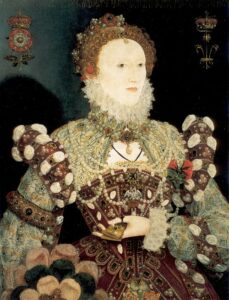
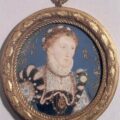
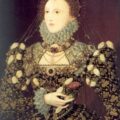
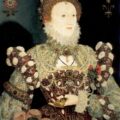
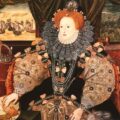
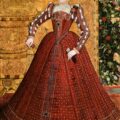
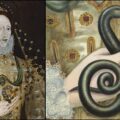


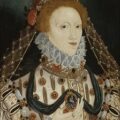
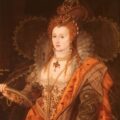
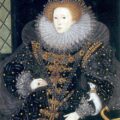
My, those shoulder rolls are… interesting! I found an article on this portrait here:
http://www.tes.co.uk/article.aspx?storycode=381153
which answered one of my questions: what IS that hanging beside her right ear? Turns out, they’re cherries, which “stand for sweetness and a reward for virtue”. I had also noticed that her feather fan features the Tudor colors of green and white, but the above article also points out that the arrangement of the differently colored feathers is meant to suggest the Tudor Rose.
I think those are gloves she’s holding, but mercy, are they narrow! All the better to emphasize her long slender hands and fingers, I would guess. I tried to zoom in on her thumb ring; it seems to have a squared-off base with a pointed, or pyramidal stone. Fascinating portrait!
One of my favourites. I love the use of the red/maroon colours as you pointed out, Claire. What a display of power and opulence!
It is, of course, not merely a portrait of a woman, or even of a Queen of England, but of England itself at the time. Because of that it can tell us so much about the mood and atmosphere of the Elizabethan age. Something to be proud of and to wonder at.
i needed to revise for a test and this website helped me a lot
Thank you for posting all of this, this is really usefull for my upcoming GCSE’S , we have to study and analys one portrait and this one is the most fascinating. Please, if anyone could help me, email me at : [email protected], many thanks ! 🙂 xo
Good on you Rob!
Thank you for this information – interesting and useful. I’m studying English language and culture in Poland – now preparing for the exam in British art.
I noticed in this portrait, she has her hair pulled back which is common of married women. We know from history that Queen Liz never got married, becoming known as the “Virgin Queen.” I thought perhaps this was done to represent how Queen Elizabeth purposely decided to not get married and basically marry herself the England, devoting her full self to ruling her country.